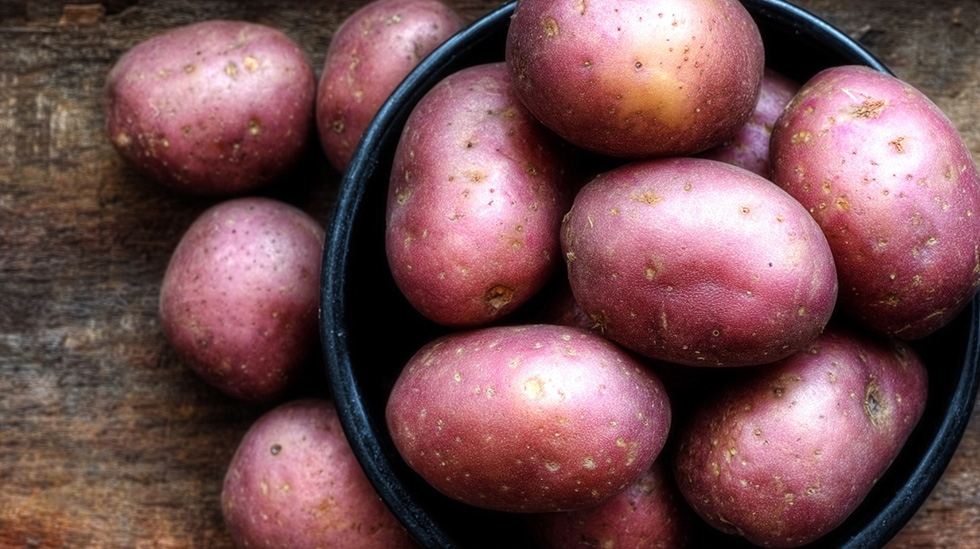Meet the red potato – the colourful star of the kitchen!
The well-known red potato is a cornerstone of our cuisine, and for good reason: it’s nutritious, versatile and the perfect ingredient for many dishes. But what makes it so special? When should you buy it? How do you store it and what is it best used for? Follow me and you’ll find out! 😉

The red potato (Latin name Solanum tuberosum) belongs to the same family as its well-known yellow-skinned counterparts, but differs from them in several ways. The potato originated in South America, mostly in what is now Peru and Bolivia, and has been cultivated for more than 7-8 thousand years. It arrived in Europe in the 16th century, where it soon became one of the most important foodstuffs.
The red potato’s speciality lies mainly in its skin – underneath its bright reddish purple skin is a creamy, whitish-yellowish flesh. Its flavour is slightly sweeter and nuttier than traditional yellow potatoes, and its texture holds together well after cooking, not falling apart easily. It is therefore an excellent choice for salads, grilling or frying.
- Yellow potatoes: softer, neutral flavour, prone to cooking. Ideal for mashes, stews and stews.
- New potatoes: an early summer speciality with a thin skin, fresh, slightly sweetish flavour. Can be eaten with the skin on.
- Parsnips: Smaller potatoes, usually cooked in their skins. They are easily recognisable and are a popular barbecue side dish.
How important is it in the kitchen?
Rating: 5/5
Potatoes are a staple of Hungarian and European cuisine – be it in casseroles, side dishes, one-dish meals or even as a soup garnish. And red potatoes bring a new colour to classic recipes with their more distinctive flavour and better texture.
Edible and non-edible parts of the plant
The edible part of the red potato is the tuber that grows underground. This is the part you buy in the shop and eat. However, it’s important to note that the rest of the plant – the leaves, stems and even the sprouting shoots – can be poisonous because they contain an alkaloid called solanine. This is especially true of the green-coloured tubers exposed to light, which you should avoid eating!
Health benefits
Red potatoes are an excellent source of vitamin C, vitamin B6, potassium and fibre. Antioxidants found in the immediate vicinity of the skin help reduce inflammation, protect cells and support cardiovascular health. According to traditional medicine, potato juice is also used to relieve mild stomach aches, although it is always best to consult a specialist.
Cultivation information
Red potatoes are grown all over Europe, mainly in the open air. In Hungary, too, more and more farms are growing them, especially in spring and early summer, and they are planted and on the shelves in late summer/early winter. In the early part of the year, they are typically imported (e.g. from Spain or France), but from mid-summer onwards, they are also often grown in their own country. It requires a warmer climate, but the Hungarian climate is favourable.
How to choose good quality red potatoes
- Avoid wrinkled, soft or frayed pieces!
- No greenish discolouration on the skin – this indicates the presence of solanine.
- Choose pieces with a firm, smooth skin.
- If you see dark spots under the skin, it could be a sign of spoilage.
Storage: to keep fresh for a long time
Store the red potatoes in a dark, cool, well-ventilated place – for example in a larder or cellar. Never put them in the fridge, where their starch will turn to sugar, which can make them taste sweet and unusual. Don’t store it with onions, as this will speed up spoilage!
In the kitchen of the world
Red-skinned potatoes are also highly prized in American, French and Spanish cuisine. In the USA, they are often used to make roasted red potatoes. In France, they are used in mustard or tarragon potato salads, while in Spanish tapas bars they are grilled and served with a spicy sauce.
Best known recipe: roast red potatoes with rosemary
Ingredients:
- 1 kg red potatoes
- 2-3 tablespoons olive oil
- 1-2 sprigs fresh rosemary (or dried)
- Coarse sea salt
- Freshly ground pepper
Preparation: wash the potatoes thoroughly (no need to peel) and cut them in halves or quarters. Toss with olive oil, salt, pepper and rosemary and bake at 200°C for about 35-40 minutes until crispy on the outside and creamy on the inside. 🍽️
Tips for use in the kitchen
- Don’t peel it, just wash it thoroughly – the skin is delicious and healthy.
- Excellent for grilling, baking, salads.
- It’s not the best for purees, but if you want a more characterful taste, try it!
- It goes well with rosemary, thyme, garlic and parsley.
- Avoid overly strong, oriental spices such as curry or ginger – they overpower the flavour.
All in all, red potatoes are a culinary treasure – not only for their beauty and taste, but also for their health benefits. If you haven’t tried it yet, it’s time to make room for it in your kitchen! 🥔❤️
